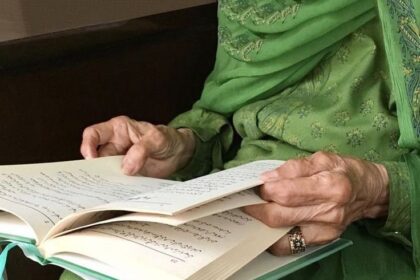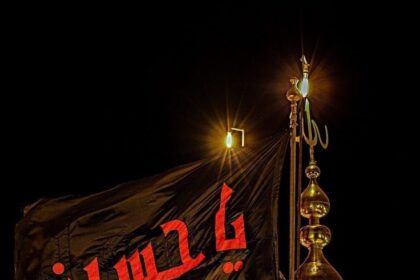سکھی پیا کو جو میں نہ دیکھوں، تو کیسے کاٹوں اندھیری راتیاں
Qawwali is an art, the type that has evolved through multiple centuries. To many, it is a connection between the earthly and the divine. Its everlasting journey has travelled through the shrines of Sufis, transiting to the courts of Mughal emperors and finally, settling in between the contemporary gatherings. The timeless nature of qawwalis has captured the hearts of many through the decades, bridging the gap between man and god. To many, qawwali is much more than just words; it is a majestic play of symphonic melodies that seem to speak to humans, with the beats of the tabla tapping the barriers of one’s heart, travelling inside through the smooth entrails guided by the rhythmical buzz of the harmonium.
This tradition of qawwali can be traced back to 1800 years in India, even before the advent of Islam. However, it became monumental with the rise of the Sufi Chishtiya order. The verses and modus operandi observed in the works of famous qawwals, be it Nusrat Fateh Ali Khan’s Man Kunto Maula, or the Sabri Brothers’ “Aaj Rang Hai,” or even delving into the more contemporary, Fareed Abu Ayaz’s Ghar Nari, can be traced back to more than 800 years.

One of the most prolific writers in Persian, Amir Khusro Dehlavi, was born to an Indian mother and a Turkish father in 1325 during the era of the Delhi Sultanate. Commonly known by the contemporary historian as a court poet, Khusro had another facet to his poetry that resonates more with the Sufi culture. This is prevalent in his prose, which is focused towards divine love and Khusro’s love for his spiritual leader, Hazrat Nizamuddin Auliya, whom he met at the ripe age of 8. This meeting led Khusro to write the famous prose, “Aj Rang Hai.” It is known that in order to escape the more common and formal musical style, “dhrupad,” Khusrau invented a new composition and taught it to children to appease his spiritual leader. Thus, it is widely believed that this composition resulted in the birth of qawwali. Concentrating on spreading the message of love, this composition of qawali was further embraced by Khusro’s forthcoming prose and his successors.

As the message of qawali spread across the subcontinent, it was further embraced by Sufi saints, sharing the messages regionally. With Baba Bulleh’s poetry, the purpose behind qawwalis was further strengthened. Although Amir Khusro’s qawalis had Punjabi and Arabian aspects in them, it can be proposed that Baba Bulleh’s poetry led qawwali into a whole new arena of culture and language, inviting more depth and resonance within his words.
The Mughal era is also known as a renaissance within the subcontinent, bringing a new face to art, music, and, on a larger scale, culture. Although qawalis were more generally sung in dargahs and shrines of Sufis, it started emerging in the courts of Mughal emperors. This advent can especially be seen during the Mughal emperor Akbar’s reign, where among his nine nauratans was a music composer attached with spirituality, Mian Tansen. Because of a lack of works done with respect to qawwali during that era, there is limited evidence to support the prevalence of qawwali in Mughal courts; the ragas employed by Mian Tansen and various other musicians of the era are similar to those of qawwali.
With the colonial rule in the subcontinent, various orthodox reformists emerged who severely criticised the culture of shrines and therefore, qawalis, terming them as innovations, and the ones practicing, termed heretics. This puritanical era led to the defamation of qawalis; however, the art was revived with qawals like Nusrat Fateh Ali Khan, the Sabri Brothers, Gulam Ali, and many more. With Nusrat’s Man Kunto Maula, Sabri Brother’s Chaap Tilak, and other qawals, this culture was once more ignited. Moreover, it is to be noted that Nusrat Fateh Ali Khan’s miraculous composition led to qawwali being recognised on an international scale. His strong voice, coupled with unique compositions, led a listener to be encaptured in a deep haze. His Qawalis were impactful to the extent that the musician, Jeff Buckley, titled Nusrat as his “Elvis.” What’s most interesting is that Nusrat’s compositions seem to remain timeless, with many listeners still thrilled by such unique work.

Lastly, as evident by the number of centuries that have passed, qawalis seem to remain perennial and everlasting in their nature. It is surprising to see how such an art was wholeheartedly embraced by so many generations, with more to come each passing day as contemporary qawals like Fareed Ayaz and Abu Muhammad emerge. Furthermore, qawwali is especially unique because of its ability to speak to a vast amount of people without cultural and religious limitations. In conclusion, since qawwali encapsulates within itself the emotions and feelings of people from centuries ago, it should be preserved with everlasting importance.
















